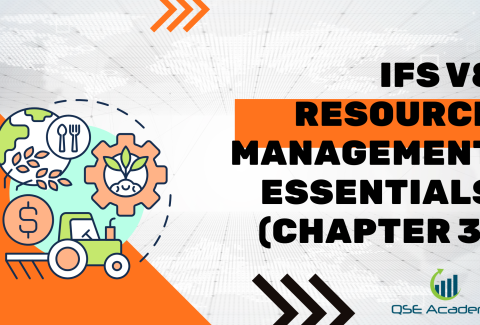IFS V8 Operational Process Controls (Chapter 4)
Last Updated on November 17, 2025 by Melissa Lazaro
Why Operational Control Is the Heart of IFS V8
Something I see often during audits is this: companies have strong documentation, solid policies, and a defined HACCP plan—but operations don’t always match what’s written. And that’s where most nonconformities appear.
IFS V8 increases expectations around how processes are executed, monitored, verified, and recorded. The standard focuses heavily on consistent behavior—not just documented intent.
By the time you finish this chapter, you’ll understand:
- How to structure operational controls in a way that’s practical and compliant
- What evidence auditors expect during implementation
- How to avoid common mistakes that lead to recalls, deviations, or poor audit outcomes
- How to make process control routine—not a scramble before certification
If you want operations that run the same way regardless of the shift, staff member, or season, this chapter matters.
Prerequisite Programs (PRPs) — The Foundation for Controlled Operations
PRPs form the baseline that allows safe production before advanced controls like CCPs and OPRPs come into play. Under IFS V8, they cover sanitation, maintenance, facility hygiene, waste handling, pest control, and other essential conditions.
Think of PRPs as the environment where controlled production happens.
To meet IFS expectations, PRPs must be:
- Documented
- Implemented consistently
- Measured and verified
- Improved based on performance
I’ve seen companies with beautifully written sanitation programs, yet inconsistent execution created cross-contamination risks. Documentation alone won’t protect the product—behavior will.
Pro Tip:
Review PRP verification records monthly. Small hygiene deviations grow fast if ignored.
Common pitfall: writing PRPs based on assumed risk instead of real operational conditions.
 Recipe, Formula & Process Specifications — Standardization for Consistency
Recipe, Formula & Process Specifications — Standardization for Consistency
IFS requires clear specifications so every batch, product, and process runs according to defined parameters—not memory or habit. Recipes, work instructions, mixing times, temperatures, and sequencing all fall under controlled specifications.
The rules are simple:
- Only authorized personnel can modify recipes
- Operators must use official, up-to-date instructions
- Process parameters must be visible at point of use
One facility dramatically reduced internal rejections simply by removing outdated printed instructions and replacing them with controlled versions.
Pro Tip:
Use visual standards at workstations—not just text-heavy SOPs.
Product Identification & Traceability — Real-Time Control and Recall Preparedness
Traceability isn’t something to test once a year—it must work every day. IFS V8 expects fully documented traceability from supplier to customer, including:
- Raw materials
- Packaging
- Rework
- Intermediates
- Finished goods
If the business claims FEFO or FIFO, there must be consistent evidence—not assumptions.
Pro Tip:
Practice traceability drills under realistic pressure. If it takes hours to retrieve data, the system isn’t ready.
Common mistake: tracking ingredients well but ignoring packaging or rework.
Process Monitoring & Measurement — Control of Critical Parameters
Monitoring verifies the system is working as intended. Under IFS, this includes:
- Time and temperature checks
- CCP and OPRP monitoring
- Allergen controls
- Weight or volume checks
- pH, moisture, or other product specifications
Monitoring must be performed by trained staff at defined frequencies—not “when convenient.” And it must be recorded immediately—not backfilled.
Pro Tip:
Provide prefilled acceptance criteria on monitoring forms. It reduces interpretation errors.
Back-writing or copying data from automation or previous shifts is one of the fastest ways to lose audit confidence.
Allergen Control — Preventing Cross-Contact and Labeling Errors
Allergens remain one of the leading causes of global recalls, so auditors examine allergen control closely. IFS expects:
- Clear zoning and storage rules
- Ingredient verification
- Validated cleaning between allergen and non-allergen products
- Label checks—including claim verification
If you produce allergen and non-allergen products on the same line, cleaning validation is non-negotiable.
Pro Tip:
Don’t rely on “visible clean” inspections. Allergen residues can’t be seen—and auditors know it.
Common pitfall: assuming cleaning validation done once remains valid indefinitely. It must be re-evaluated after process or equipment changes.
Foreign-Body Control — Detection, Prevention & Verification
Foreign-body control includes physical, detection, and procedural controls such as:
- Metal detectors
- X-ray systems
- Magnets
- Sieves and filters
- Glass and brittle plastic registers
- Knife and tool control systems
IFS expects:
- Defined test frequencies
- Documented verification
- Clear escalation rules when equipment fails a check
If a metal detector test fails during production and no immediate corrective action occurs, most auditors will classify it as a major nonconformity.
Pro Tip:
Document not only the failure—but the evaluation of potentially affected product.
Packaging & Labelling Checks — Accuracy, Verification and Release
Labels must be correct. Claims, allergen statements, batch coding—even marketing wording—all fall under compliance.
Under IFS V8, controls must include:
- Label approval workflow
- Pre-production labeling checks
- In-process verification
- Final check before release
A single incorrect label can trigger a costly recall.
Common pitfall: storing similar-looking labels or packaging formats next to each other without segregation.
Pro Tip:
Use barcode scanning or visual boards to prevent mix-ups—especially during changeovers.
Rework & Non-Conforming Product — Controlled, Documented, and Evaluated
Rework must be handled with the same rigor as any raw material. That means:
- Traceability
- Authorization
- Hazard evaluation
- Controlled reintegration
- Quality checks before release
Nonconforming product must be clearly identified, segregated, and evaluated—not put aside informally.
Pro Tip:
Use dedicated hold tags or digital “hold status” flags to prevent accidental use.
FAQs
How often should operators be retrained on operational controls?
At least annually—or sooner if changes occur.
Can traceability be partial or limited to certain ingredients?
No—all inputs affecting the finished product must be traceable.
Do we need to validate controls even if performance seems stable?
Yes—validation confirms the control works, verification ensures it continues to work.
Conclusion — Turning Controls Into Daily Discipline
Operational process control isn’t about checking boxes—it’s about building predictable production. When monitoring is real-time, documentation is accurate, and processes are consistent across all shifts, compliance becomes part of the workflow—not an external requirement.
Melissa Lavaro is a seasoned ISO consultant and an enthusiastic advocate for quality management standards. With a rich experience in conducting audits and providing consultancy services, Melissa specializes in helping organizations implement and adapt to ISO standards. Her passion for quality management is evident in her hands-on approach and deep understanding of the regulatory frameworks. Melissa’s expertise and energetic commitment make her a sought-after consultant, dedicated to elevating organizational compliance and performance through practical, insightful guidance.








